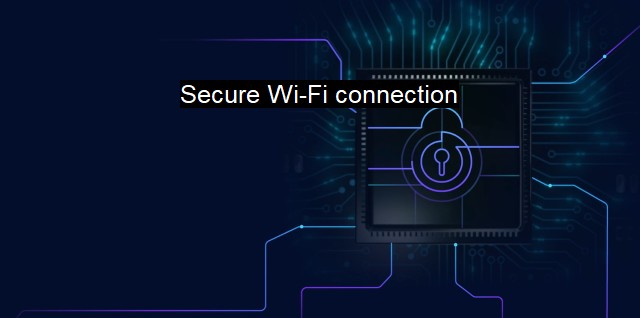What is Secure Wi-Fi connection?
Strengthening Wi-Fi Security in an Era of Advanced Technology: Exploring WPA and WPA2 Encryption Protocols
A Secure Wi-Fi connection represents a wireless network that utilizes a range of security protocols to ensure data and information sent over the network are private, secure, and resistant to unauthorized access. securing one's Wi-Fi connection is a critical measure to prevent cyber threats such as hacking, phishing, malware, and other disruptive or destructive activities perpetrated by cybercriminals.To understand the importance of Secure Wi-Fi Connections, it is important to grasp how these connections function. Wi-Fi signals are essentially radio waves that carry data between devices and the router, meaning that without proper security protocols, anyone within range of your Wi-Fi could potentially intercept these signals, gaining access to your personal or sensitive information.
Several different security protocols exist within the context of Secure Wi-Fi Connection including WEP, WPA, WPA2, and WPA3. WEP, though an older and less secure option, was one of the pioneering securities for wireless connections. It uses encryption to protect data from being intercepted but is not recommended for use today due to its vulnerability to modern hacking techniques.
WPA (Wi-Fi Protected Access) was introduced as a notion to the WEP's flaws and showcased improved security features. security vulnerabilities were still present, prompting the development of WPA2. WPA2 applies a stronger encryption mechanism- the Advanced Encryption Standard (AES)- making it harder for cybercriminals to break in. The latest standard, WPA3, gives users the highest level of security, providing sophisticated encryption and robust cyber-attack prevention.
Utilizing these security protocols significantly reduces the risk of cyber attacks and keeps your data protected from prying eyes. securing a Wi-Fi connection is not only about implementing the most appropriate security protocol. Some other necessary actions include setting strong and unique passwords, regularly updating router firmware, disabling remote administration, and constraining network range to the necessary space, which aids in preventing potential attackers from connecting to your network.
Cybersecurity is a growing concern in our ever-advancing technological world; as such, the utilization of an antivirus software becomes equally important. Antivirus software acts as an integral line of defense against malware and other threats that could bypass network security. It continuously scans your devices, seeking out suspicious behavior or known threats, quarantining those threats when discovered. Antivirus not only functions preventively but can also detect and eliminate threats that have already found their way into the system.
While antivirus and secure Wi-Fi connections represent solid first step measures against cyber threats, public Wi-Fi networks often pose another threat. This is because public Wi-Fi is accessible to everyone, with many networks lacking rudimentary security measures which exposes them to various security vulnerably. the use of a VPN (Virtual Private Network) can help protect data on public networks by encrypting all data travel to and from your device, providing an additional layer of security.
a Secure Wi-Fi Connection represents a necessary practice involving multiple security measures, aimed at ensuring the confidentiality, integrity, and accessibility of one's data and information. From prevention, detection, mitigation, to response, using the right combination of network security and antivirus tools contributes notably to establishing a robust cybersecurity defense against evolving threats in this digital age.

Secure Wi-Fi connection FAQs
What is a secure Wi-Fi connection?
A secure Wi-Fi connection is a network that is protected with encryption and authentication mechanisms to prevent unauthorized access and data theft. Secure Wi-Fi connections encrypt all data transmitted between devices, making it difficult for hackers to steal sensitive information.What is the most secure Wi-Fi connection type?
The most secure Wi-Fi connection type is WPA2 (Wi-Fi Protected Access II), which is currently the industry standard for securing Wi-Fi networks. WPA2 uses a stronger encryption algorithm than its predecessor, WPA, and provides better protection against attacks such as brute force and dictionary attacks.How can I secure my Wi-Fi connection?
To secure your Wi-Fi connection, you can follow some simple steps such as changing the default password, enabling network encryption (WPA2), disabling SSID broadcasting, and setting up a guest network. You should also keep your antivirus software and operating system up-to-date to protect against potential security vulnerabilities.What are the risks of using an unsecured Wi-Fi connection?
Using an unsecured Wi-Fi connection can expose your sensitive information to cybercriminals who can intercept and steal your data. This can lead to identity theft, financial fraud, or even ransomware attacks. Additionally, hackers can use unsecured Wi-Fi networks to spread malware or launch cyberattacks on other users connected to the same network.| | A | | | B | | | C | | | D | | | E | | | F | | | G | | | H | | | I | | | J | | | K | | | L | | | M | |
| | N | | | O | | | P | | | Q | | | R | | | S | | | T | | | U | | | V | | | W | | | X | | | Y | | | Z | |
| | 1 | | | 2 | | | 3 | | | 4 | | | 7 | | | 8 | | |||||||